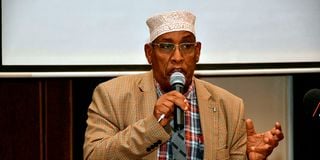Premium
Exclusion of some communities in employment causing acrimony - report

National Assembly Committee on National Cohesion and Equal Opportunities chairperson and Mandera West MP Yussuf Adan Haji. In a report tabled in Parliament, the committee says marginalisation of some communities is the root cause of the widening gap of lack of cohesion among Kenyan communities.
The exclusion of some communities from employment in the public service is causing bitterness in the country, according to the National Assembly Committee on National Cohesion and Equal Opportunities.
The committee, in its first report on the Diversity Audit of Employment in Public Institutions tabled in Parliament, delivered a damning verdict on how employment in the country is skewed with some communities not being considered at all for jobs in the public service.
The committee, chaired by Mandera West MP Adan Haji, said the exclusion and marginalisation of some communities is the root cause of the widening gap of lack of cohesion among Kenyan communities.
The committee, which has met with various public institutions over the past three months on diversity in employment, says in the report that there is a huge imbalance in employment in the public service, with a few dominant ethnic communities over-represented.
"There was a consistent pattern of exclusion of some communities across all institutions that appeared before the committee and in most institutions it is evident that some communities have been excluded from employment at all cadres, causing bitterness in the country," the report says.
"The discourses of exclusion and marginalisation are responsible for the continued lack of cohesion and unity among Kenyan communities," the report says.
Article 232 of the Constitution states that the civil service should be representative of Kenya's diverse communities.
In addition, Section 7 of the National Cohesion and Integration Act, 2008 requires all public institutions to ensure that they are representative of Kenya's diversity by ensuring that no institution has more than one third of its membership from the same ethnic group.
The committee is now proposing an amendment to the Act to ensure that no more than one-fifth of staff come from the same ethnic representation.
"The Committee notes that since the adoption of the new Constitution, public institutions have continued to recruit from over-represented communities," the report says.
"It is worth noting that the Kikuyu ethnic community has the highest representation in the country at 17 per cent of the national population," the report said.
The committee noted in its report that there is a need for strong political will and recognition by leaders that Kenya as a nation is more important than any one ethnic community.
The committee sampled 14 public institutions with which it held meetings. These include the Teachers Service Commission (TSC), Anti-counterfeiting Authority, National Social Security Fund (NSSF), Kenya Bureau of Standards (KEBS), Kenya National Shipping Line, Pwani University, Kenya Maritime Authority (KMA), Coastal Development Authority, Kenya Marine and Fisheries Research Institute, Communication Authority of Kenya (CAK), Kenya Trade Network Agency, Kenya Medical Research Institute, Kenya Generating Electricity Company (KenGen) and Kenya National Highways Authority (Kenha).
At TSC, the majority of teachers come from three communities: Kalenjin (17.17 per cent), Kikuyu (17 per cent) and Luhya (15.25 per cent).
In the Secretariat, however, the majority of staff are from only two communities - Kikuyus (18.18 per cent) and Kalenjin (14.50 per cent).
At the Anti-Counterfeiting Authority, only 16 communities out of 46 ethnic groups are employed, with the majority coming from Kikuyu (18.10 per cent), Luo (13.30 per cent), Kalenjin (11.40 per cent) and Akamba (11.40 per cent).
At the NSSF, the majority of employees come from three communities: Kalenjin (18.27 per cent), Kamba (17.52 per cent) and Luos (13.30 per cent).
At the Kenya Bureau of Standards, the majority of employees come from only three communities, with Kalenjin leading with 15.96 per cent, Kikuyu with 18.47 per cent and Luo with 14.31 per cent.
Kenya National Shipping Line, the majority of employees are from the Luo (31.58 per cent), Luhya (21.5 per cent) and Kamba (21.5 per cent) communities.
Also Read: Ruto regime - Meet reality
At Pwani University, the majority of employees are from four ethnic communities: Mijikenda (33.49 per cent), Luo (10 per cent), Luhya (15.35 per cent) and Kikuyu (10.93 per cent).
At the Kenya Maritime Authority, the majority of employees are from the Luo (15.97 per cent), Digo (10.8 per cent) and Kikuyu (9.24 per cent) communities.
At the Communication Authority of Kenya, the majority of employees are from only three communities - Kalenjin (19.43 per cent), Kikuyu (19.43 per cent) and Luhya (18.63 per cent).
At the Kenya Electricity Generating Company, employees come from three communities - Kikuyu (27.79 per cent), Kalenjin (16.91 per cent) and Luo (11.80 per cent).
Four communities dominate the list of employees at the Kenya National Highways Authority. They are Kikuyu (24.16 per cent), Kalenjin (14.68 per cent), Luo (19.33 per cent), Kalenjin (14.68 per cent) and Luhya (10.78 per cent).
The committee recommends that the National Cohesion and Integration Act of 2008 be amended to require the head of the public service to report to Parliament on a quarterly basis on the composition of the public service, with particular emphasis on the representation of ethnic and marginalised groups.
It has also recommended that heads of public institutions in regional areas should come from a community other than the local community.
It also wants public institutions to consider using local vernacular radio stations, in addition to daily newspapers, to advertise job vacancies.
The lawmakers also want public bodies to replace retiring staff with people from under-represented communities and groups.





